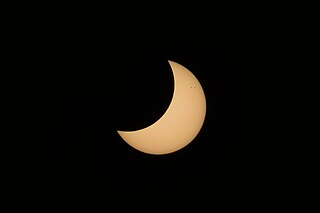| Solar eclipse of April 29, 2014 | |
|---|---|
 Partial from Adelaide, Australia | |
| Type of eclipse | |
| Nature | Annular |
| Gamma | −1.00001 |
| Magnitude | 0.9868 |
| Maximum eclipse | |
| Duration | - |
| Coordinates | 70°36′S 131°18′E / 70.6°S 131.3°E |
| Max. width of band | - km |
| Times (UTC) | |
| (P1) Partial begin | 3:52:38 |
| (U1) Total begin | 5:47:50 |
| Greatest eclipse | 6:04:33 |
| (U4) Total end | 6:09:20 |
| (P4) Partial end | 8:14:28 |
| References | |
| Saros | 148 (21 of 75) |
| Catalog # (SE5000) | 9539 |
An annular solar eclipse occurred at the Moon's descending node of orbit on Tuesday, April 29, 2014,[1][2] with a magnitude of 0.9868. A solar eclipse occurs when the Moon passes between Earth and the Sun, thereby totally or partly obscuring the image of the Sun for a viewer on Earth. An annular solar eclipse occurs when the Moon's apparent diameter is smaller than the Sun's, blocking most of the Sun's light and causing the Sun to look like an annulus (ring). An annular eclipse appears as a partial eclipse over a region of the Earth thousands of kilometres wide. The Moon's apparent diameter was near the average diameter because it occurred 6.2 days after perigee (on April 23, 2014, at 1:20 UTC) and 7.2 days before apogee (on May 6, 2014, at 11:20 UTC).[3]
It will be unusual in that while it is a total solar eclipse, it is not a central solar eclipse. A non-central eclipse is one where the center-line of totality does not intersect the surface of the Earth (when the gamma is between 0.9972 and 1.0260). Instead, the center line passes just above the Earth's surface. This rare type occurs when totality is only visible at sunset or sunrise in a polar region.
This eclipse's gamma value was closer to 1 than any other eclipse from 2000 B.C. to 3000 A.D. This means the center of the Moon's shadow passed almost exactly at the surface of the Earth, barely missing the Antarctic continent by a few kilometers.
The center of the Moon's shadow missed the Earth's South Pole, but an annular eclipse was visible from a small part of Antarctica, and a partial eclipse was visible from parts of Antarctica and Australia.
- ^ "April 29, 2014 Annular Solar Eclipse". timeanddate. Retrieved 12 August 2024.
- ^ "Antarctic prime spot for Tuesday's solar eclipse". The Brownsville Herald. 2014-04-30. p. 21. Retrieved 2023-10-26 – via Newspapers.com.
- ^ "Moon Distances for London, United Kingdom, England". timeanddate. Retrieved 12 August 2024.
